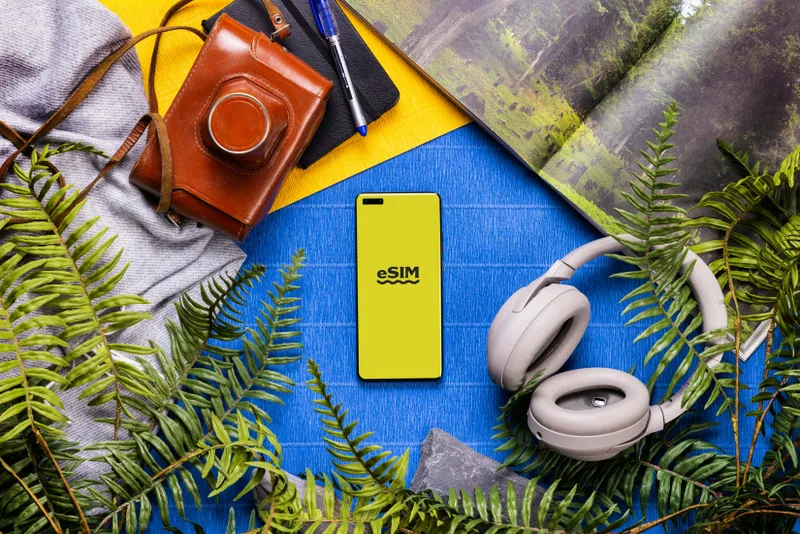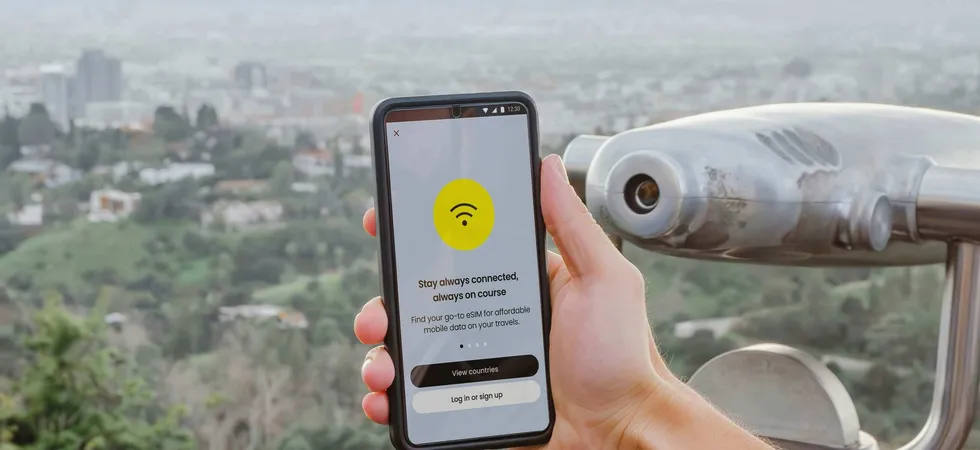How precisely do eSIMs differ from the actual SIM cards we’ve been using for years? There are a few distinctions to mention, at least. Our article will address all of your concerns, whether you’re thinking about updating your phone or just interested in the most recent developments.
First, we will discuss the key distinctions between an eSIM and a SIM card. Then, we will cover the idea of eSIMs itself, along with the advantages and disadvantages of this technology. We’ll also examine every application for eSIMs.
Curious about the overall benefits of eSIMs? No problem – we’ll dedicate a section to understanding whether eSIMs are truly better than physical SIMs, considering factors like flexibility, ease of setup, security, and connectivity. Finally, we’ll wrap up by suggesting whether you should choose eSIM vs physical SIM.
The main differences between an eSIM and a SIM card
Form Factor
eSIM. Embedded app fused onto the device’s motherboard.
Physical SIM Card. Removable plastic card in various sizes (nanoSIM being the most common).
Flexibility
eSIM. Can store multiple profiles and switch between carriers or plans on the fly.
Physical SIM Card. Limited to one profile at a time, requires physical removal and insertion of a new SIM card to switch carriers or plans.
Price
eSIM. No upfront cost (often included in phone price).
Physical SIM Card. May have a small activation fee depending on the carrier.
Ease of Use
eSIM. Activation is typically done remotely by scanning a QR code or entering an activation code provided by the carrier.
Physical SIM Card. Requires visiting a carrier store or having a SIM ejector tool to physically insert or remove the card.
Security
eSIM. Cannot be physically lost or stolen. Even if the device is lost or stolen, the eSIM profile can be remotely locked or disabled.
Physical SIM Card. Can be lost or stolen, potentially compromising a phone number, data, and access to two-factor authentication codes.
Use Cases
eSIM. Ideal for smartphones with dual SIM functionality, wearables like smartwatches, tablets that require cellular data connectivity, and travel. (easy switching between local and international carriers)
Physical SIM Card. Traditional use for smartphones. Well-suited for users who don’t frequently change phones or carriers.
Durability
eSIM. Less susceptible to physical damage like bending or breaking.
Physical SIM Card. More prone to physical damage if not handled carefully.
Compatibility
eSIM. Not all devices currently support eSIM technology, but the majority of new ones do.
Physical SIM Card. Universally compatible with all cellular phones.

What is an eSIM?
An eSIM is a programmable chip that stores your cellular network information, which is similar to a physical SIM card. Nevertheless, unlike its physical equivalent, the eSIM is permanently bonded to the motherboard of your device, so there’s no more fussing with small trays or stressing about losing an important piece of plastic and PIN/PUK codes.
You should be aware of a few drawbacks of using eSIM in addition to its many advantages. Both sides of the coin are covered here:
eSIM Pros
- Enhanced flexibility. An eSIM’s true strength is that it allows for multiple cellular profiles. This way, both your work and personal phone numbers can be active on a single device. There are also no problems with switching to a local data plan while traveling internationally. All you need to do is to select the plan, purchase, and activate it.
- Effortless setup. Activating an eSIM is a breeze. Remote activation options like scanning a QR code or entering an activation code make connecting to your chosen network straightforward.
- Superior security. Physical SIM cards can be easily lost or stolen, potentially compromising your data. Since eSIMs are embedded within your device, they cannot be physically removed. Even in case of a lost or stolen device, the eSIM profile can be remotely locked or disabled by your carrier, which makes safeguarding your information even in such unpleasant situations easier.
- Efficient space utilization. The absence of a SIM slot in favor of eSIMs conserves space within your device, enabling manufacturers to craft slimmer phone designs while accommodating extra features or components.
- Simplified device switching. Upgrading to a new phone with an eSIM can be effortless. Some carriers even offer the ability to transfer your eSIM profile wirelessly to your new device, eliminating the need to contact your carrier or wait for a replacement SIM card.
eSIM Cons
- Limited compatibility. Not all devices currently support eSIM technology. However, it’s becoming so common that some phones don’t even have a physical SIM slot — they are eSIM only. To avoid the trouble of incompatibility, before making the switch, check if the device you want to own is eSIM-compatible.
- Carrier dependence. Switching carriers might require contacting your provider to reprogram the eSIM, unlike simply swapping a physical SIM card.
- Potential for issues. While highly uncommon, technical glitches can occur during eSIM activation.

Benefits of eSIMs for everyday use
Here are the primary reasons you might consider switching to an eSIM:
- eSIM makes your trips easier. Many travelers face problems like scrambling for local SIM cards or getting hit with roaming charges seemingly out of nowhere. Purchase data plans from local carriers on the fly by simply scanning a QR code or entering an activation code. That’s one worry less when trying to get around unfamiliar territories.
- Comfortable business trips. Keep your work number active for critical calls and messages while seamlessly switching to a local data plan for internet access. No need for multiple devices or expensive international roaming fees.
- Effortless dual SIM. It’s easy to store both your work and personal numbers (or two personal numbers – whatever works for you) on the same device and switch between them with a tap.
Is eSIM better than a physical SIM?
eSIM is a formidable competitor of the conventional physical SIM card. Though, which one is the best choice? To assist you in choosing which best meets your needs, let’s examine the main distinctions between physical and eSIMs.
Flexibility
Here, eSIM takes the crown. It allows you to store multiple cellular profiles and switch between work and personal lines or connect to local networks while traveling easily. Physical SIMs, on the other hand, are limited to one profile at a time, requiring a physical swap for switching.
Easy Setup
eSIM shines again when considering the setup. Activation is typically done remotely through a scannable QR code or code entry, eliminating trips to carrier stores. Physical SIMs require visiting a store or using a SIM ejector tool, which can be inconvenient.
Security
The security part also goes to eSIM. Since they’re embedded within your device, they cannot be physically removed. Even in case of a lost or stolen phone, the eSIM profile can be remotely disabled. A lost or stolen physical SIM, meanwhile, could easily compromise your data and phone number.
Connectivity
Both eSIM and physical SIM cards offer reliable network connectivity. However, eSIMs might have a slight edge for some users when activating a data plan from a local carrier, even if your phone is locked to your home network (you should confirm this with your carrier).
eSIM vs Physical SIM: which one should you choose?
Both options have their merits. Physical SIM cards are universally compatible and well-suited for users who don’t change phones or carriers frequently. However, they are limited to one profile at a time and can be easily broken, lost, or stolen, which can compromise your data.
eSIMs boast superior flexibility, allowing you to store multiple cellular profiles and switch between carriers or plans with ease. Additionally, eSIMs are more secure as they cannot be physically removed from your device. They also streamline phone upgrades with potential wireless transfer of your eSIM profile to your new device.
eSIMs might have compatibility limitations and require contacting your carrier to switch providers. However, the convenience and flexibility they offer are hard to beat.
It’s important to note that eSIMs are a definite game-changer for travelers. That is because it eliminates the need for local SIM cards and roaming charges. If you’re not traveling a lot, there’s no need to go overboard to obtain an eSIM-compatible phone but keep this flexibility in mind the next time you’re purchasing a new device.
Ultimately, the best choice depends on your needs. If you prioritize flexibility, security, and a future-proof solution, then eSIM technology is the perfect fit for you.

